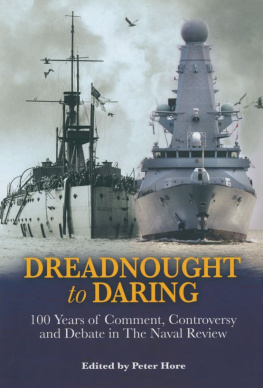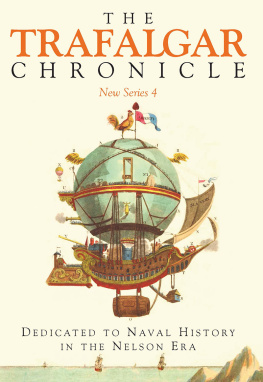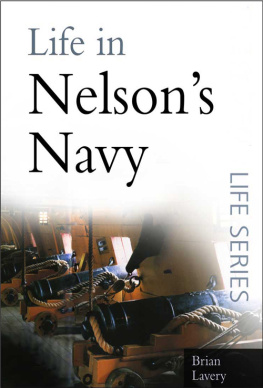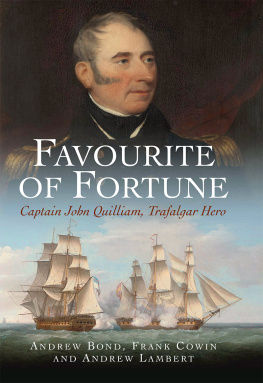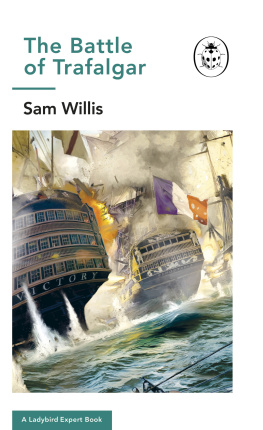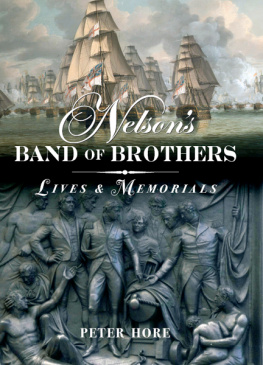THE TRAFALGAR CHRONICLE
Dedicated to Naval History in the Nelson Era
New Series 1
~~~~~~~
Journal
of
THE 1805 CLUB
Edited by
P ETER H ORE
In association with The 1805 Club
Text copyright individual contributors 2016
First published in Great Britain in 2016 by
Seaforth Publishing,
An imprint of Pen & Sword Books Ltd,
47 Church Street,
Barnsley S70 2AS
www.seaforthpublishing.com
British Library Cataloguing in Publication Data
A catalogue record for this book is available from the British Library
ISBN 978 1 4738 9572 0 ( PAPERBACK )
ISBN 978 1 4738 9574 4 ( EPUB )
ISBN 978 1 4738 9573 7 ( KINDLE )
All rights reserved. No part of this publication may be reproduced or transmitted in any form or by any means, electronic or mechanical, including photocopying, recording, or any information storage and retrieval system, without prior permission in writing of both the copyright owner and the above publisher.
The right of the individual contributors to be identified as the authors of this work has been asserted by them in accordance with the Copyright, designs and Patents Act 1988.

Presidents Foreword
I welcome this, the first of a new series of the Trafalgar Chronicle, the yearbook of The 1805 Club.
Over the last quarter of a century, the Trafalgar Chronicle has established itself as the leading depository of knowledge about the Georgian navy, while its subject matter has broadened to include not just new research and rare details of the life of Admiral Lord Nelson and the Battle of Trafalgar, but also about other men, great and small, about strategy, operations and tactics in the sailing navies of the Georgian era, and not just in the British navy, but in the navies of Britains rivals and allies.
Last year The 1805 Club marked its silver jubilee with a twenty-fifth anniversary edition, in the year of the bicentenary of the Battle of Waterloo, which was devoted to the theme of the victory of sea power which made Waterloo possible. In 2016 the first volume of the new series takes a slightly different format, but continues the idea of being themed. The relationship between the Royal Navy and the United States Navy has been extremely important throughout their shared history, and I am delighted that this is celebrated in this edition which contains new information and the results of new research into North America and North Americans in the sailing era.
Another feature of the Trafalgar Chronicle has been the publication of rarely seen images of the age, and this practice is maintained here.
Over its life the Trafalgar Chronicle has taken on an international character and here too the contributors come from Britain and overseas. They include foremost experts in their fields of study, as well as antiquarians and amateurs who have addressed their interests with the thoroughness and energy which is unique to them, and I wish to thank them each and every one for their contribution.
A DMIRAL S IR J ONATHON B AND GCB DL
Former First Sea Lord
President of The 1805 Club

Frontispiece from Nelson's Letters from the Leeward Islands by Geoffrey Wales, The Golden Cockerel Press, 1953. (From the collection of Rear-Admiral Joseph F Callo, USN)
Editors Foreword
On 23 June 1800, during the USAs Quasi-War with France, Commodore Thomas Truxton wrote from USS Constellation to George Cross commanding the US frigate John Adams:
A good understanding with the British Navy officers is highly necessary as we are acting in one common cause against a perfidious enemy, and we should endeavour to cement our union by acts of kindness, civility and friendship to each other on all occasions for it is unquestionably our interest and their interest always so to do.
Then in 1859 Rear-Admiral Josiah Tatnall USN, who had fought against the British in the War of 1812, remarked during an incident in the Second Opium War, when he and his sailors voluntarily served British guns against the Chinese, that blood is thicker than water. Blackwoods magazine responded: Gallant Americans! You and your Admiral did more that day to bind England and the United States together than all your lawyers and pettifogging politicians have ever done to part us!
For your editor, these two quotations sum up the special relationship which has existed down two centuries between the Royal Navy and the United States Navy, a relationship which, as Truxton reminds us, started as soon as the ink dried on the Treaty of Paris in 1783, in the era of the Georgian navy which has been the focus of the Trafalgar Chronicle over its twenty-five years.
I therefore have much pleasure in dedicating this edition to North America and North Americans in the era of the Georgian sailing navies. There are two articles about the Star-Spangled Banner the first time that the flag was seen at sea, and the writing of the words to the US national anthem, another article which challenges accepted wisdom about impressment as the cause of the War of 1812, two about charting under sail, and, as much of what we know about the sailing navy has come down to us via the marine painters of the age, there is a superbly illustrated article about Thomas Buttersworth. Several other articles address the great men and small of the age, many of whom had mixed backgrounds in Britain and in the USA.
Again the editor is grateful to contributors from several countries who have written so ably for the Trafalgar Chronicle, contributors who include leading contemporary scholars, as well as some first-time writers. I am also grateful to all those who have kindly refereed articles, and to the new publishing and production team who include Julian Mannering, Stephanie Rudgard-Redsell and Michael Harrington, the quality of whose work is self-evident.
In 2017 the Trafalgar Chronicle will look at the Royal Marines and the US Marine Corps in the Georgian era: it is never too soon to sharpen your quills, and proposals for articles are welcome now. Please contact the editor at .
P ETER H ORE
Nicholas Biddle: Americas Revolutionary War Nelson
Chipp Reid
The explosion lit up the night, showering the sea and everything on it with debris. The crew of the 64-gun HMS Yarmouth stood dumbfounded at the scene. For nearly fifteen minutes, the nimble Yankee frigate Randolph had pummelled the much larger British warship, whose captain, Nicholas Vincent, appeared on the verge of surrendering the Yarmouth when his opponent suddenly exploded. Among the dead was the American commander, Captain Nicholas Biddle.

Portrait of Captain Nicholas Biddle by Orlando Lagman, after a painting attributed to James Peale. (US Naval History and Heritage Command)
If any Continental Navy officer could lay claim to being Americas Horatio Nelson, it was Biddle. Arguably the most accomplished officer in the fledgling colonial fleet, Biddles seamanship and courage were beyond question. Washington Irving, best known for Rip Van Winkle and the Legend of Sleepy Hollow, wrote in a biography of Biddle sixty years after Biddles and more than thirty after Nelsons death, that Nelson had warned his Royal Navy colleagues at the onset of the American Revolution that Biddle would be Englands toughest opponent at sea. Although Irving never gave the source of Nelsons warning, if anyone knew Biddle and the Americans abilities, it was Nelson.


